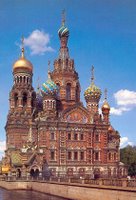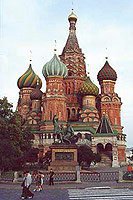Monday, October 31, 2005
The Value Of Structures
Blogcorner Preacher is wondering about the role and appropriateness of the great structures of the church, you know, cathedrals, etc.
 Nowhere are such structures more pagan-seeming than in Russia. It has been common practice there to build such grand structures to commemorate events.
Nowhere are such structures more pagan-seeming than in Russia. It has been common practice there to build such grand structures to commemorate events.
The "Church On The Spilt Blood" seen here was erected to commenorate the assasination of Tsar Alexander II. It never functioned as a house of worship. I was constructed as and has always been, save for the years of total neglect by the communists, an elaborate and overwhelming memorial. Royalty may have done some religious ceremony in it, but it was never a genuine house of God.
 The same can be said for this building -- the extremely famous St Basil's on Red Square in Moscow.
The same can be said for this building -- the extremely famous St Basil's on Red Square in Moscow.
This was built by Ivan the Terrible, the first real Tsar, to commemorate a victory over Poland. Again, it was never really used as a house of worship. Again, royalty may have used it for private religous matters from time to time, but is was never a place where God was pronounced the the people
Now consider this -- faith, the gospel, religion survivied the best efforts of Stalin, and the entire history of the Soviet Union. They may have neglected these places. But they dared not consider demolishing them -- it would have fomented revolt.
Strange as it may seem to our puritanical protestant minds -- these elaborate structures, with all their wasted money and seeming idolatry, maintained faith where faith was actively derided and persecuted. The power of their symbolism could not be overcome.
One must remember how incredibly literate this age is. There was a time, in fact most of history, when that was not the case. Even after the advent of printing, it was a long time before widespread literacy took hold. When that was the case, such structures, and things like orthodox icons, played a role similar to what coffee table Bible plays today. But these structures will last much longer than the inexspensively bound Bible on my coffeee table.
I can't begin to figure out the theology of all this - it is contrary to my puritanical training, but I have seen it work (I have visited not only current Russia, but was in the Soviet Union) I cannot deny its reality.
I've been in St. Paul's in London, and, wow. It's something. I've also been in many of the grand cathedrals in France, and some elsewhere in Europe. Wow again. I'm of two minds when entering such places. The first is usually, "surely they could have found a better use for the money this all cost?" Like, maybe, feed the hungry, clothe the poor, shelter the homeless. That sort of thing.I too have been in many of these glorious structures and I too have had the same thoughts, but a few experiences have brought me down solidly believing in their value.
The second is to be in awe at some of the craftsmanship, sculptures, and paintings. Beautiful. What price to put on it? Ad majorem dei glorium, as my Jesuit brothers say. As to what Paul might have said, don't know. He was a bit of a curmudgeon, in a righteous cause, for which he gave his life. I suspect he'd not have liked it much.
 Nowhere are such structures more pagan-seeming than in Russia. It has been common practice there to build such grand structures to commemorate events.
Nowhere are such structures more pagan-seeming than in Russia. It has been common practice there to build such grand structures to commemorate events.The "Church On The Spilt Blood" seen here was erected to commenorate the assasination of Tsar Alexander II. It never functioned as a house of worship. I was constructed as and has always been, save for the years of total neglect by the communists, an elaborate and overwhelming memorial. Royalty may have done some religious ceremony in it, but it was never a genuine house of God.
 The same can be said for this building -- the extremely famous St Basil's on Red Square in Moscow.
The same can be said for this building -- the extremely famous St Basil's on Red Square in Moscow.This was built by Ivan the Terrible, the first real Tsar, to commemorate a victory over Poland. Again, it was never really used as a house of worship. Again, royalty may have used it for private religous matters from time to time, but is was never a place where God was pronounced the the people
Now consider this -- faith, the gospel, religion survivied the best efforts of Stalin, and the entire history of the Soviet Union. They may have neglected these places. But they dared not consider demolishing them -- it would have fomented revolt.
Strange as it may seem to our puritanical protestant minds -- these elaborate structures, with all their wasted money and seeming idolatry, maintained faith where faith was actively derided and persecuted. The power of their symbolism could not be overcome.
One must remember how incredibly literate this age is. There was a time, in fact most of history, when that was not the case. Even after the advent of printing, it was a long time before widespread literacy took hold. When that was the case, such structures, and things like orthodox icons, played a role similar to what coffee table Bible plays today. But these structures will last much longer than the inexspensively bound Bible on my coffeee table.
I can't begin to figure out the theology of all this - it is contrary to my puritanical training, but I have seen it work (I have visited not only current Russia, but was in the Soviet Union) I cannot deny its reality.





